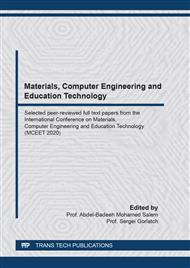[1]
ISO 3887:2017 Steels — Determination of the depth of decarburization[S].
Google Scholar
[2]
ISO 4967:2013 Steel — Determination of content of non-metallic inclusions — Micrographic method using standard diagrams[S].
Google Scholar
[3]
ASTM E930-99(2007) Standard Test Methods for Estimating the Largest Grain Observed in a Metallographic Section (ALA Grain Size)[S].
DOI: 10.1520/e0930-99
Google Scholar
[4]
ASTM E2375-16 Standard Practice for Ultrasonic Testing of Wrought Products[S].
Google Scholar
[5]
ISO 148-1:2016 Metallic materials — Charpy pendulum impact test — Part 1: Test method[S].
Google Scholar
[6]
ISO 6892-1:2019 Metallic materials — Tensile testing — Part 1: Method of test at room temperature[S].
Google Scholar
[7]
Shi daoji. Practical statistical method of extreme value[M]. Tianjin: Tianjin Science and Technology Press, (2006).
Google Scholar
[8]
LIU Wen-qing. The Methods of MLE Numerical Calculate Using Excel Sof tware[J]. Application of Statistics and Management, 2006, 25(5): 544-548.
Google Scholar
[9]
ISO/IEC GUIDE 98-3:2008/SUPPL 2:2011Uncertainty of measurement — Part 3: Guide to the expression of uncertainty in measurement (GUM:1995) — Supplement 2: Extension to any number of output quantities[S].
Google Scholar
[10]
GB 50199-2013 Unified standard for reliability design of hydraulic engineering structures [S].
Google Scholar
[11]
GB 5009-2012 Load code for the design of building structures[S].
Google Scholar
[12]
Melchers R E. Extreme value statistics and long-term marine pitting corrosion of steel[J]. Probabilistic Engineering Mechanics, 2008, 23(4): 482−488.
DOI: 10.1016/j.probengmech.2007.09.003
Google Scholar
[13]
Zhou Guoqiang, Wang Xueqing, Liu Rui. A modified generalized extreme value distribution methodology to predict the maximum corrosion depth of nuclear pipes[J]. Journal of Central South University (Science and Technology), 2013, 44(5): 1926-1931.
Google Scholar
[14]
LI Jan-hui, ZHAN Ke-qiang, DENG Zong-cai. Distribution Regularity of Flexural Impact Resistance of Synthetic Macro-fiber Reinforced Concrete[J].Journal of Architecture and Civil Engineering, 2007, 24(4): 54-59.
Google Scholar
[15]
ZHOU Ze-ren, SHU Yin-biao, DONG Cun, etc. Statistical Analysis of Wind Energy Distribution Based on Mixture Weibull Distribution Model[J]. Journal of Applied Statistics and Management,.
Google Scholar
[16]
JIANG Ping, XING Yun-yan, WANG Bo, etc. Storage Reliability Prediction Method for Missiles Undergoing Periodic Maintenance[J]. Missiles and Space Vehicles, 2020, 373(2): 99-104,110.
Google Scholar
[17]
ASTM E2283-08(2019)Standard Practice for Extreme Value Analysis of Nonmetallic Inclusions in Steel and Other Microstructural Features[S].
DOI: 10.1520/jai100418
Google Scholar
[18]
Hou Shu-min, LI You-rong, LIU Guang-lin. Application of K-S Test and Wavelet Analysis in Rolling Bearing Fault Diagnosis[J]. Coal Mine Machinery, 2005, (1): P129-130.
Google Scholar
[19]
Nan Bo. Statistical analysis of snow load based on K-S inspection method[J]. Journal of Lanzhou University of technology. 2012, 38(1): P115-119.
Google Scholar
[20]
LIU Zhi-fei, YAN Pei-jun, XU Ren-ping, etc. Effect of Strain Age on Impact Toughness of ADB610 Steel[J]. Development and Application of Materials. 2013, 28(3): 36-39.
Google Scholar
[21]
DIAO Hongquan, LIN Jiahui, Yao Huiming. Statistical parameter estimation method and application of Gumbel distribution[J], Science and Technology Innovation Herald, 2019 , (08): 130-132.
Google Scholar
[22]
ZHANG Xinsheng, CAO Naining, LI Yayun. Residual Life Prediction of Buried Oil and Gas Pipelines Based on Gumbel Extreme Value Type I Distribution[J]. Journal of Chinese Society for Corrosion and Protection, 2016, 36(4): 370-374.
Google Scholar
[23]
DONG Shuanglin. Statistical analysis of parameter estimation methods for Gumbel distribution[J]. SHUI LI XUE BAO, 1987,(11):35-42.
Google Scholar
[24]
HU De, GUO Gangzheng. Application Comparison of least square method, moment method and maximum likelihood method[J]. Statistics & Decision, 2015, (9): 20-24.
Google Scholar
[25]
LI Shun-jing. Maximum Likelihood Estimator Method Based on Incomplete Data - EM Algorithm[J]. J Chongqing Technol Business Univ. ( Nat Sci Ed), 2014, 31(5): 29-33.
Google Scholar
[26]
CHEN Wenqing. The Basic Thought about Maximum Likelihood Method and Application [J]. Journal of Shaoguan University (Natural Sience), 1996, 17(4):24-27.
Google Scholar
[27]
FEI Shao-ji. An Approach to Maximum Likelihood Estimation[J]. Sichuan University of Arts and Science Journal (Natural Science Edition), 2008,18(5):1-3.
Google Scholar
[28]
Shi yimin, Xu Wei, Qin chaoying, etc. Mathematical Statistics[M]. Beijing: Beijing Science Press, (2015).
Google Scholar
[29]
Sheng zou, Xie shiqian, Pan chengyi. Probability Theory and Mathematical Statistics[M]. Beijing: Higher Education Press, (2008).
Google Scholar
[30]
YUN Wenzai. Comparison of statistical methods for testing distribution [J]. Inner Mongolia Statistics, 2008, (1):39-40.
Google Scholar
[31]
DING Yongmei, LIU Lijun, LEI Qing. Discussion on Parameter Estimation Methods of Gumbel Distribution[J]. Journal of Xuzhou Institute of technology (Natural Sciences Edition), 2018, 33(3): 61-67.
Google Scholar


